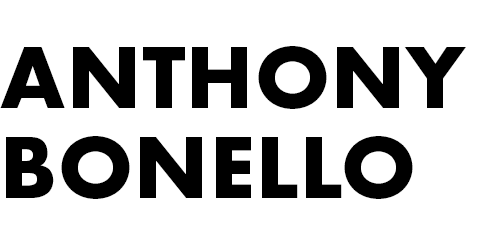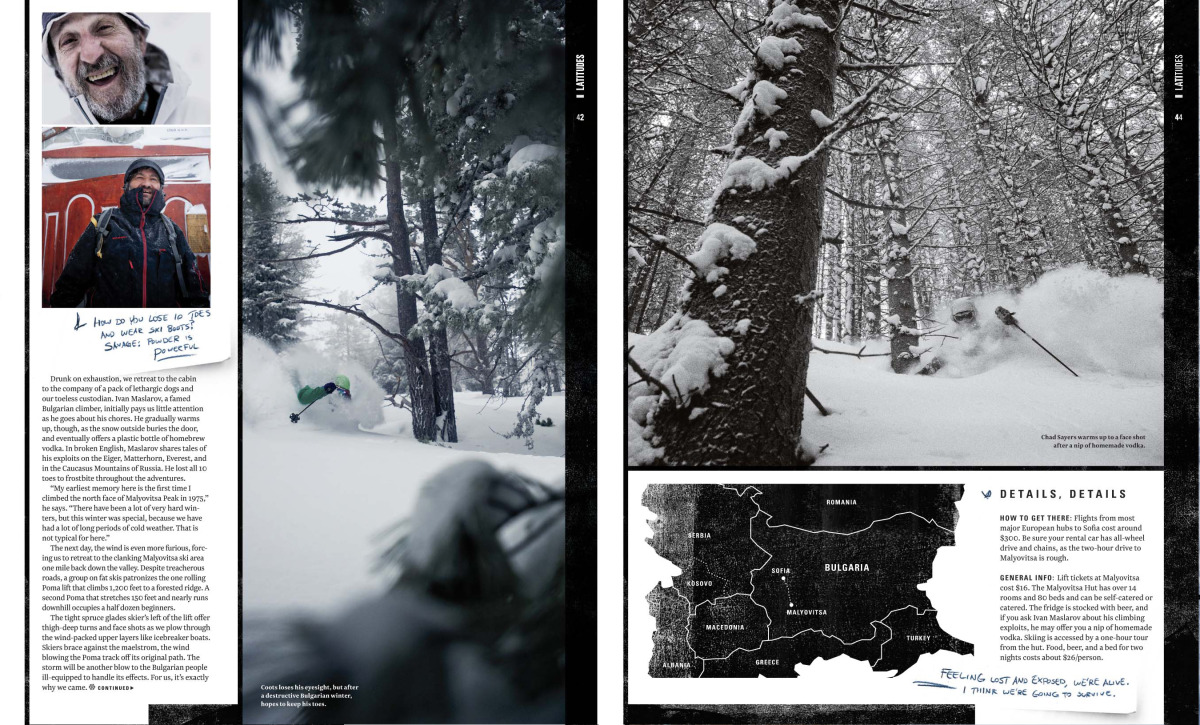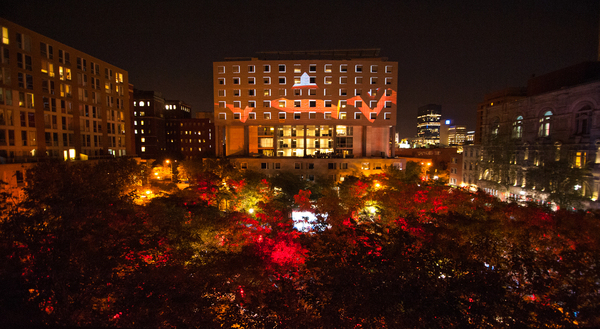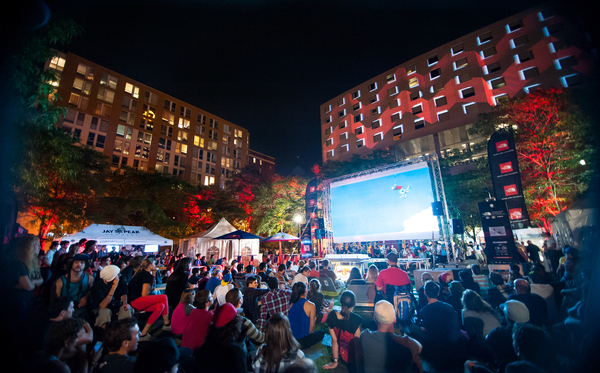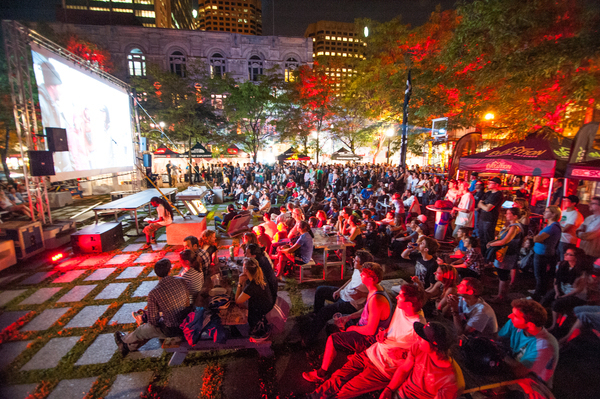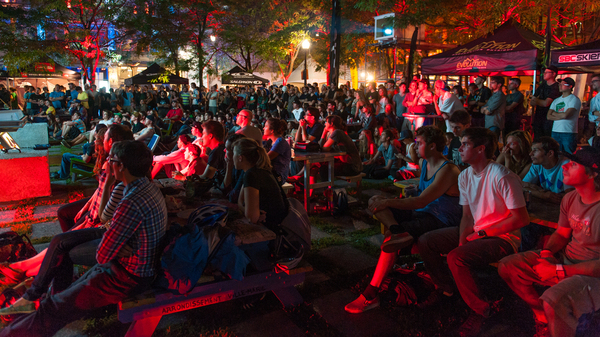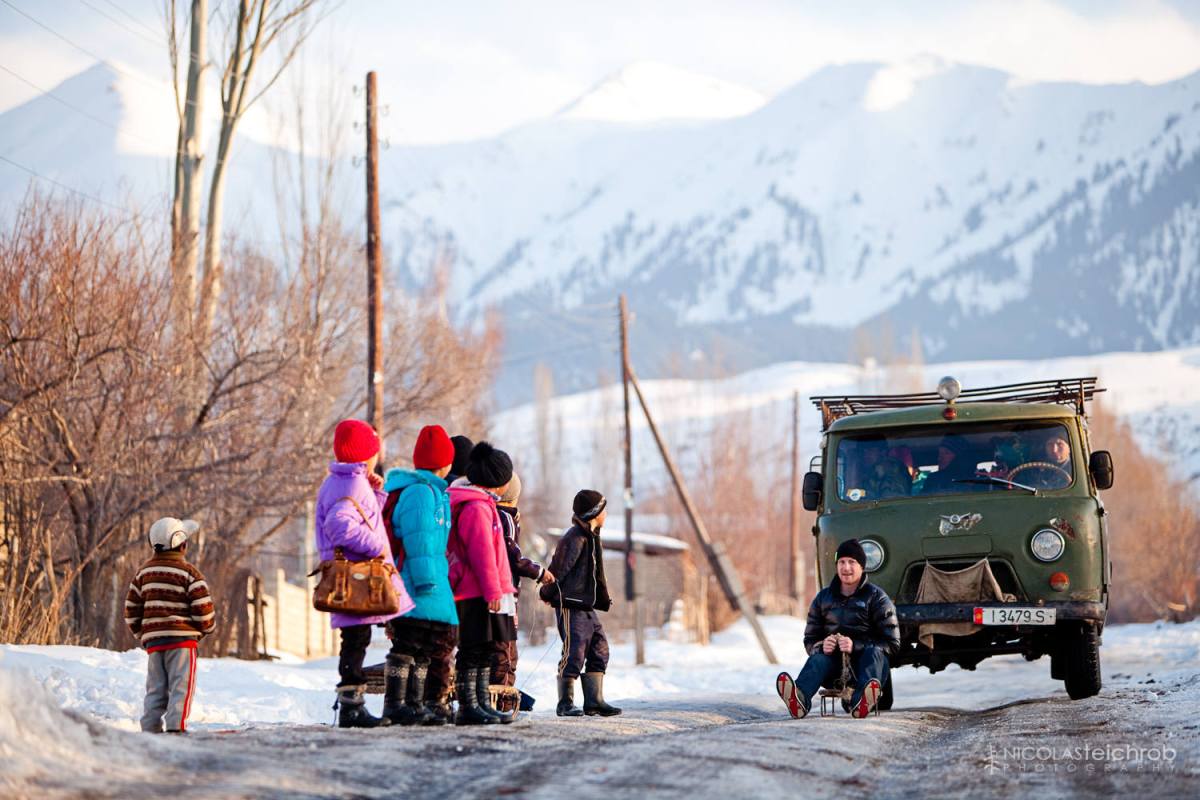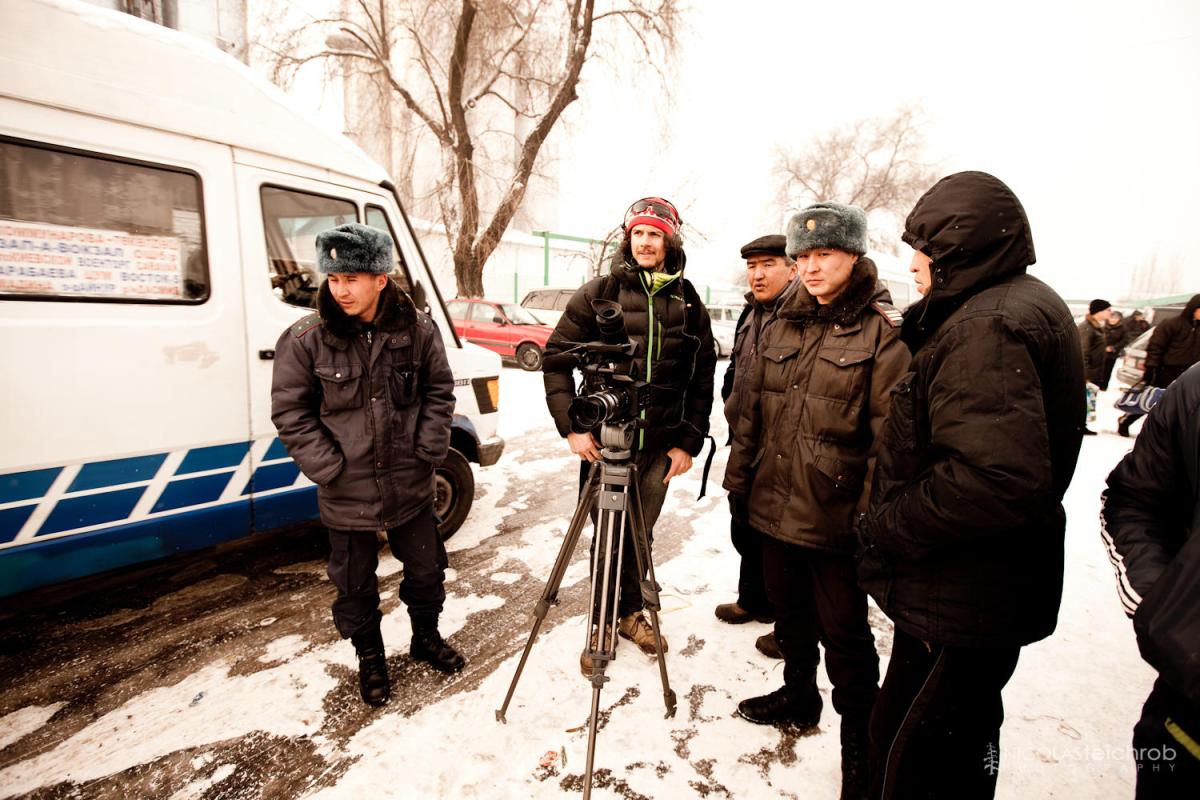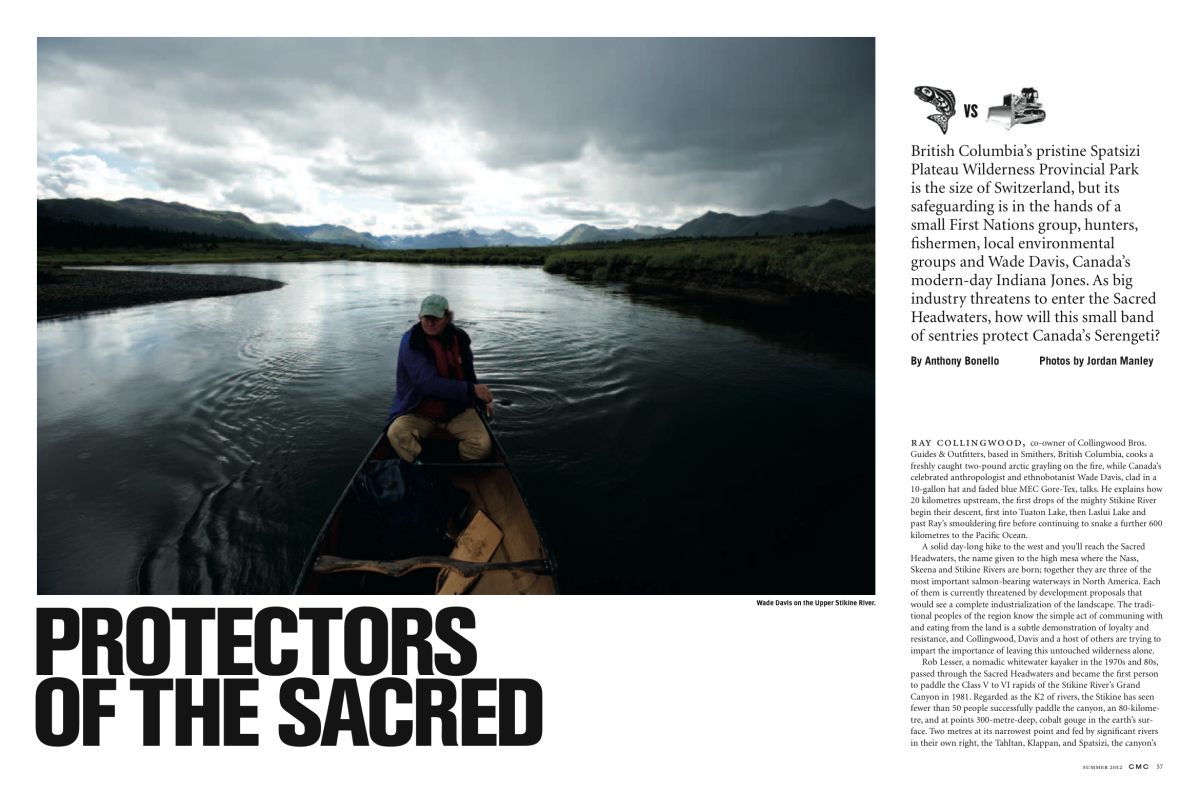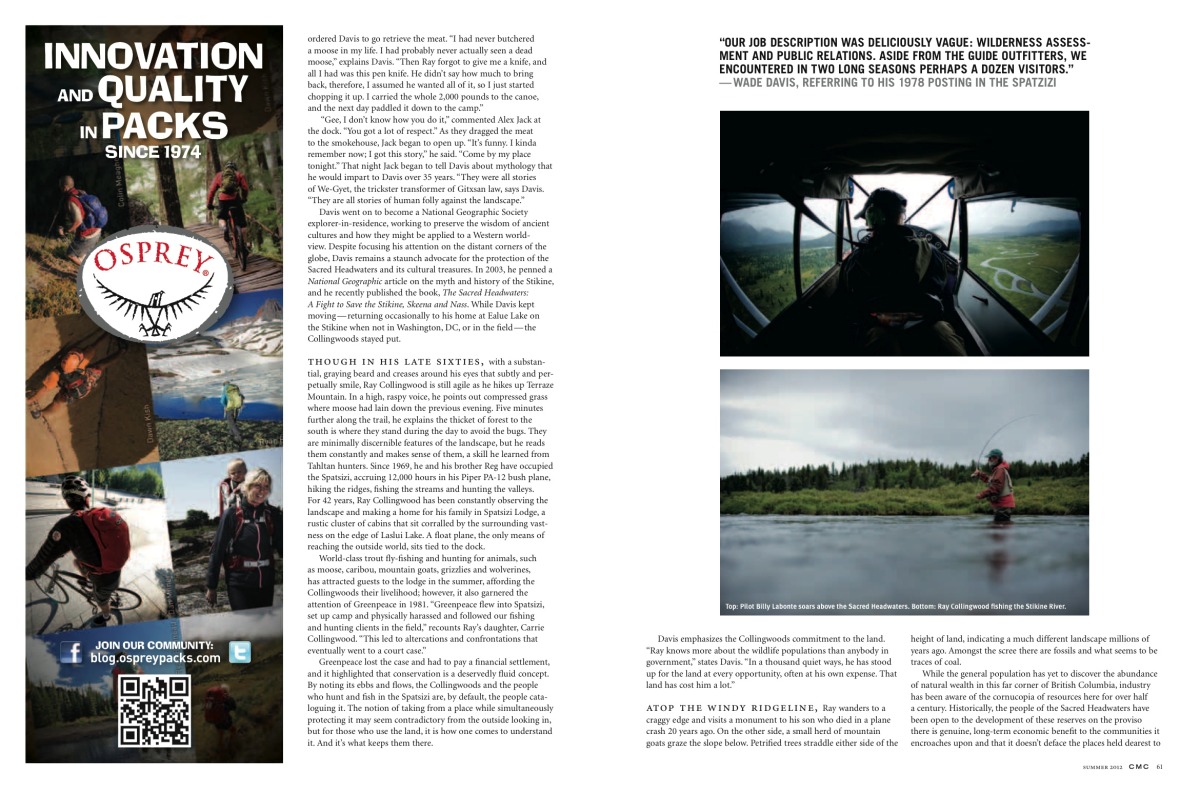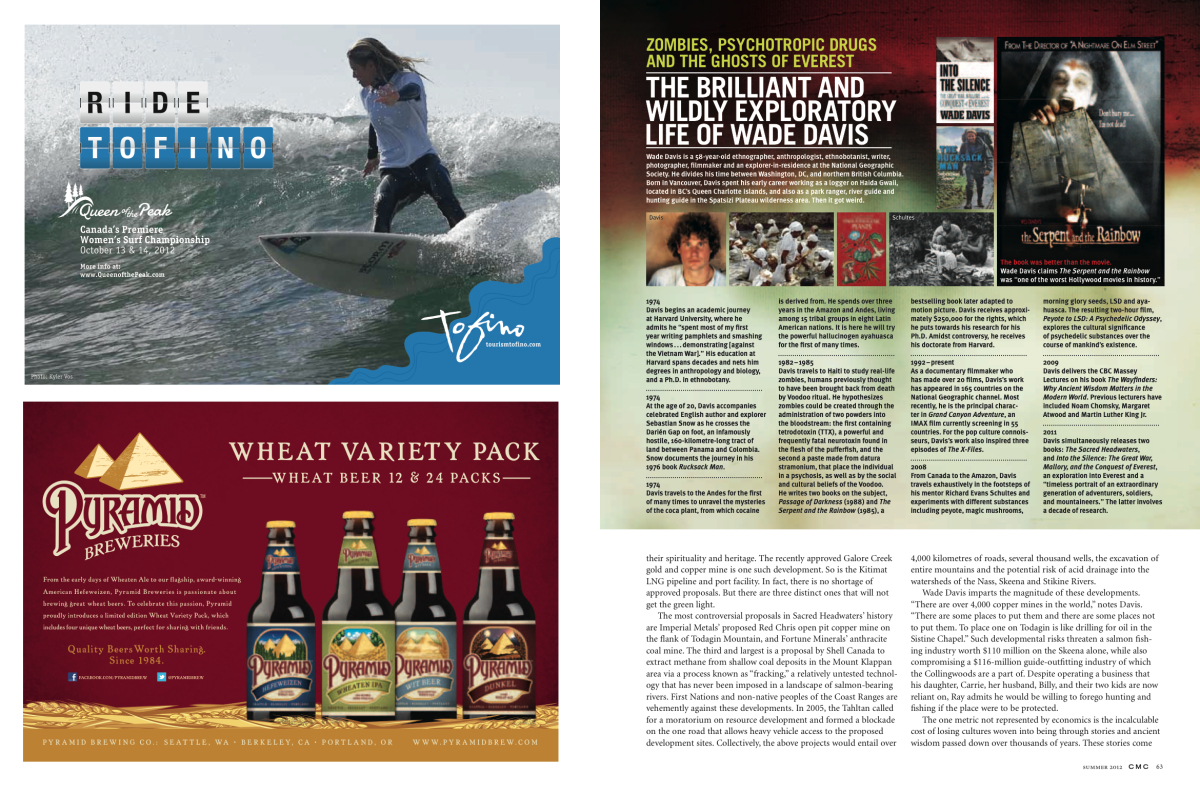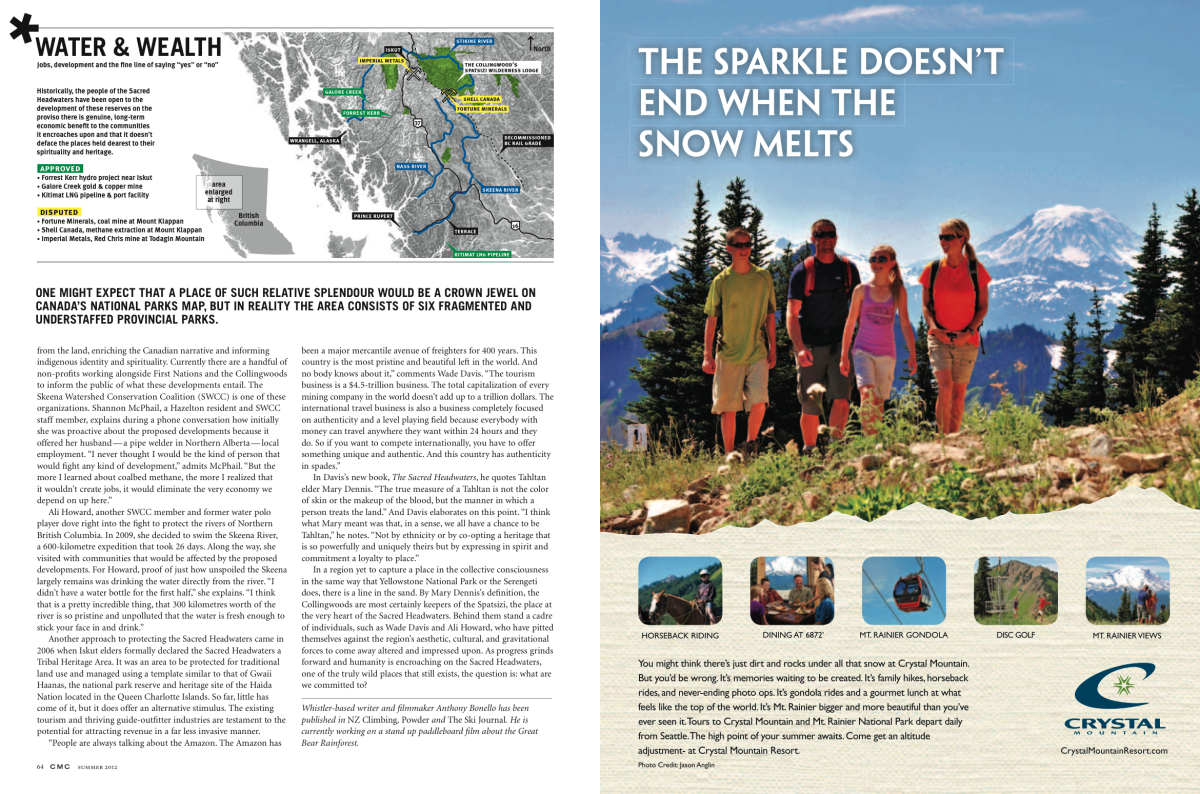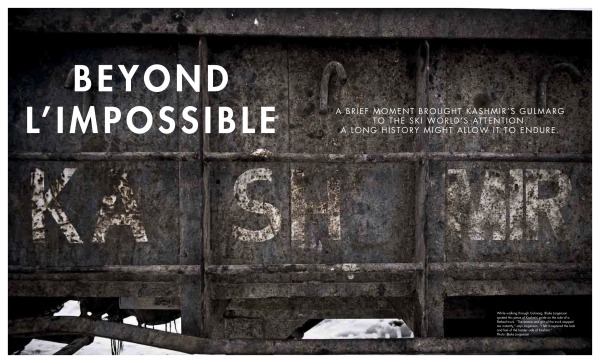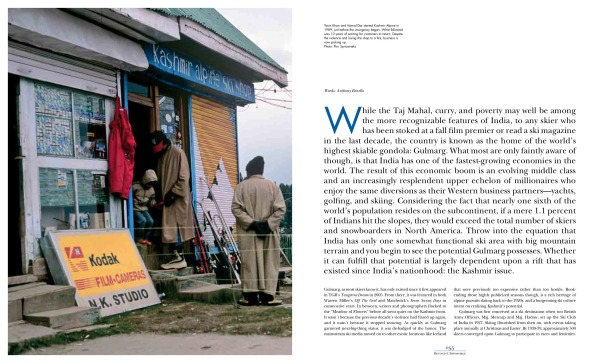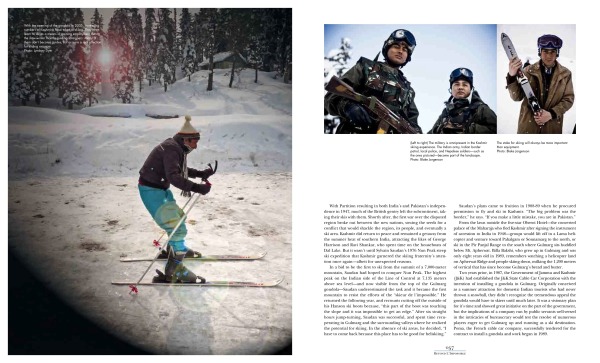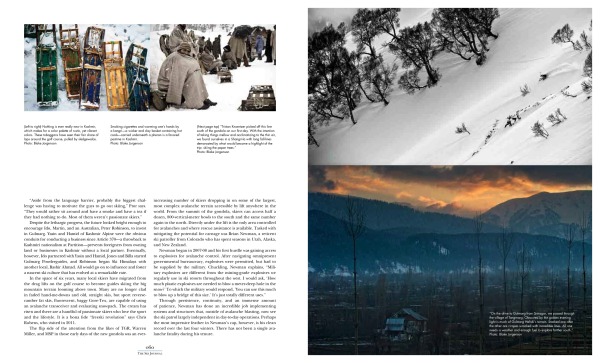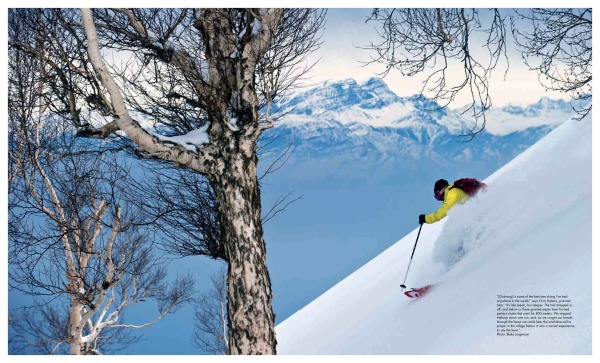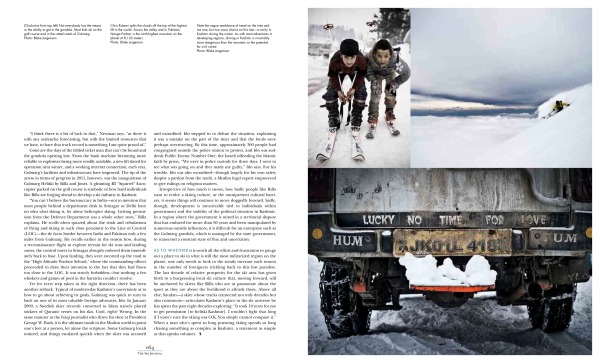In January last year I travelled to Austria to shoot a Salomon Freeski TV episode. Austria is the borth place of modern skiing and coupled with its zealous following of ski racing, it is a place that one must visit as sort of skiing pilgrimage. This episode pays tribute to the past, the racing culture and new freeride movement. Hopefully it makes you want to go ski. Enjoy!
A Hundred Year Storm- Powder Mag Latitude
Last March I travelled to Eastern Europe with Jordan Manley, Forrest Coots and Chad Sayers in the hope of skiing some of the snow that fell across vast swathes of the continent. The storm eventually became a state of emergency and what we encountered was part of the aftermath- a little less violent, but equally as insightful. I joined the crew as a writer and the story was published in Powder Magazine.
Jalpak Tash- A Kyrgyzstan Epic ONLINE
Jalpak Tash- A Kyrgyzstan Epic from b4apres media on Vimeo.
Last week Jalpak Tash was released online for your viewing pleasure. By the weekend it had made the Vimeo Staff Picks list which I am extremely stoked about. A big thank you goes to The North Face for making the trip and film happen. I must also thank Ryan Koupal and his crew at 40 Tribes Backcountry for arranging everything, not least the yurt that he lived in for the week. And finally Nicolas Teichrob for all his hard work and creativity shooting in Kyrgyzstan.
Origins- Selkirk Wilderness Skiing and Sherpas Cinema
Origins from Selkirk Wilderness Skiing on Vimeo.
Last March I joined the Sherpas Cinema crew at Selkirk Wilderness Skiing in Meadow Creek, BC. SWS was the first catski operation ever, and they hired the Sherpas to capture the legacy and the still incredible skiing that made this spot Alan and Brenda Drury's first choice destination in 1975. And you can be sure that it still gets some of the deepest and lightest snow on the planet as is evidenced by the conditions we had during the week we shot at the lodge. Enjoy and prepare to have a hankering for some powder.
STAND Film- Haida Gwaii Expedition
After 12 months of planning and dreaming, the STAND expedition finally came to fruition. Delayed a month because we simply weren't ready and still didn't have a boat to make our base camp out of, touching down in Masset after an incredible float plane flight across Hecate Strait to see Soul Haven tied up at the dock made it all a reality. The next 2 weeks we would be living on a 40 foot sail boat coasting down the eastern shoreline of Haida Gwaii. Iconic for its First Nations culture and famous for its natural beauty, the trip didn't disappoint.
Hartley Bay Photo Video Workshop
Last week I made the trek to Hartley Bay, a 160 person First Nations community only accessible by boat or float plane in the heart of the Great Bear Rainforest at the mouth of the Douglas Channel. The traditional territory of the Gitga'at people, it is a remote community surrounded by some of the most pristine forest in the world. Nicolas Teichrob, who I am working on the STAND film project with, had spent time in Hartley Bay last November shooting the trailer for STAND. After meeting the people and sharing his work, he and I were invited back to conduct a photo and video workshop with students and staff of the community school.Hoping to develop an audio visual studio at the school, they wanted to learn how to use their new Canon DSLR cameras along with how to use Adobe Lightroom and iMovie. Some of the teachers were interested in integrating multimedia in their language curriculum which seemed a great idea.
Jalpak Tash World Premiere at IF3 in Montreal
It's that time of year again when the International Freeski Film Festival (IF3) lights Montreal up for 3 days of films and parties. This year I was glad to have Jalpak Tash, the short film I directed in Kyrgyzstan, make its world premiere to an open air crowd at The North Face Outdoor Theater. Playing on the first evening along side some of the years best films was a real honour and it is always nice to know that your work is appreciated and that skiing remains diverse and open.
A huge thanks goes out to Felix Rioux and his IF3 team for continuing to develop an awesome event and platform for the freeski community to gather and for filmmakers to showcase their work. Secondly thanks again to The North Face for making Jalpak tash possible.
The North Face Kyrgyzstan Yurt Trip
In February I made it to Kyrgyzstan to ski and film in the Tien Shan Mountains based out of a yurt, or traditional nomadic tent. Teaming up with photographer Nicolas Teichrob and The North Face athletes athletes Mike Hopkins, Leah Evans and Izzy Lynch, we spent 2 weeks in a part of the world that we largely knew nothing about. Flying into Bishkek we were greeted with -25 C temperatures and a thriving metrolpolis. Making our way to Karakol a more agarian aspect of the country presented itself. Skiing the local ski hill was a novel attraction before we spent a night with a local Kyrgyz family. Once in the yurt, we had everything we needed for a great week of skiing. Kas and Anarbek, two local Kyrgyz, cooked and kept the fire burning while we ventured out with Ryan Koupal of 40 Tribes Backcountry and our guide Ptor Spricenieks. Koupal launched the operation as a means of helping to develop winter based tourism in a country still recovering from the collapse of the Soviet Union. Working around dangerous avalanche conditions, altitude and myelf recovering from being struck down with pneumonia, we enjoyed numerous first descents and some incredibly warm hospitality from the local people.
Despite it's challenges we came away with some great imagery that we will distill down to a short film to released in the fall. A big thanks goes to The North Face for making the trip a reality and to Ryan Koupal and his team at 40 Tribes Backcountry.
Look out for the film and an assortment of feature articles on stands near you.
Check out Nicolas' blog for more images here.
The North Face Truax Mountain Bike Shoot
 Camped out at 2000m in the alpine above the old mining town of Bralorne two hours north of Pemberton, BC, was where I found myself at the end of August. Working with Sherpas Cinema filming Mike Hopkins and Kamloops' latest rising star Matt Miles lay down first descents in the Bendor Range was a true highlight of a pretty action packed summer. An exploratory mission made possible by The North Face, the idea was to document a frontier of mountain biking only now beginning to be explored- true freeride, big mountain descents. Equipped with quad bikes and old miners roads Mike at Matt setup a shuttle circuit that gave them access to 2000ft shale lines right out the front of camp. The helicopter came in once the boys found their rhythym and then things got really exciting. Flying deeper into the mountains we found larger and larger chutes that offered the most adventourous style of riding I have ever seen. Having seen the descents with my own eyes, watching footage and reviewing Blake Jorgenson's photos, the scale is still difficult to wrap one's head around. Thankfully, you will get the opportunity to try to understand the ruggedness of the riding and the landscape when the edit is complete so watch this space.
Camped out at 2000m in the alpine above the old mining town of Bralorne two hours north of Pemberton, BC, was where I found myself at the end of August. Working with Sherpas Cinema filming Mike Hopkins and Kamloops' latest rising star Matt Miles lay down first descents in the Bendor Range was a true highlight of a pretty action packed summer. An exploratory mission made possible by The North Face, the idea was to document a frontier of mountain biking only now beginning to be explored- true freeride, big mountain descents. Equipped with quad bikes and old miners roads Mike at Matt setup a shuttle circuit that gave them access to 2000ft shale lines right out the front of camp. The helicopter came in once the boys found their rhythym and then things got really exciting. Flying deeper into the mountains we found larger and larger chutes that offered the most adventourous style of riding I have ever seen. Having seen the descents with my own eyes, watching footage and reviewing Blake Jorgenson's photos, the scale is still difficult to wrap one's head around. Thankfully, you will get the opportunity to try to understand the ruggedness of the riding and the landscape when the edit is complete so watch this space.
To see some more pictures from the week check out Blake's awesome gallery here.
Salomon Freeski TV Season 6 Trailer
The trailer for the coming season of Salomon Freeski TV just dropped and if this doesn't make you want to skiing, nothing will. Vaulted to the apt description of "12 hort films", I had the good fortune of shooting one of this seasons episodes in ridiculously good conditions in Austria. Stay tuned for the first episode October 8th.
Deep Summer Photo Challenge with Scott Markewitz
During the Crankworx Mountain Bike Festival here in Whistler I was contacted by photographer Scott Markewitz to help edit his Deep Summer Photo Challenge slideshow. Scott is a stalwart in action sports photography with over 400 covers to his name. The format for the competition is that 6 photographers have 72hrs to shoot photos and a day to compile their slideshows before being judged in front of a raucous crowd of mountain bikers. Having always enjoyed the event as a spectator it was fun to be on the otherside of the equation. The capture was all Scott and it was a blast hanging out with legends like Brett Tippie, Richie Schley along with Katie Holden, Cam Zinc and the inseparable Bernie Kerr and Eliiot Jackson. Be it standing in the forest listening to Tippie's jokes, trying to write haikus, or trying to record voice overs of said haikus, I haven't laughed that much in a long time. Putting the slideshow together was arduous at times, more so because of a lack of sleep and an imminent deadline. It wasn't without it's glitches either as we previewed the final export 20mins before the deadline only to have an issue with the music. We resolved it as we drove to deliver the file and made the 6pm deadline.
The next evening the show went down outside at the Olympic Plaza and was joined by 5 other really great slideshows. In the final washup we claimed second behind rising star Rueben Krabbe.
I'd like to thank Scott for the call, the athletes for the good times and Michelle Leroux for creating and putting on such a great event. Finally, a massive shoutout to Dave Petch for the rocking tune to bring the images to life.
Enjoy the show!
The Heiltsuk people protesting the Northern Gateway project.
Welcome to Heiltsuk Territory- Bella Bella JRP
During the week of the Bella Bella Joint Review Panel (JRP) I unknowingly walked in on a hyperbolic demonstration of Heiltsuk culture and pride. I was initially there to spend time with the students of the Bella Bella Community School who are building their very own hand made cedar stand up paddleboards to film and document the process as part of my new film project "STAND". Between woodshop classes though, I had the opportunity to sit in on the JRP presentations and as a consequence learn more about Heiltsuk culture and oral tradition than I bargained for.
The JRP hearing was convened to collect “oral evidence, which is typically traditional—Aboriginal traditional knowledge, information that can’t be communicated to the Panel in writing.”1 What ensued was two and a half days of the Heiltsuk people sharing their experience and connection to the land and ocean. Supernatural stories informed by the geography of the Heiltsuk traditional territory that are passed down from one generation to another where also made public. At it's most basic level, and shamefully so, it required the Heiltsuk in their own home to articulate and justify the value of their traditional territory to their culture.
The hearings began with controversy when the panel cancelled the first day due to security concerns and this was widely publicized in the mainstream media. It was an impressive display as the panel descended the airplane steps to be confronted by elders dressed in traditional regalia, singing and drumming, and the road lined with children vocally protesting the the Northern Gateway project. What prompted me to write this, however, was the notion that the three members of the panel are perhaps some of the luckiest people in Canada.
Why you might ask? The coastal First Nations of BC have archeological evidence of occupying this region that dates back 10,000 years. Their cultures are rich in art, traditional medicine, song, dance and story telling. To this day many people rely on the land and ocean for food and this was evidenced by elders sitting in the audience munching on herring roe harvested using hemlock boughs that morning. Herring roe is a salty delicacy with the texture not unlike undercooked quinoa and is entirely palatable. Despite the terrible hangover of the residential school system, and the environmental erosion that has taken place from over fishing and forestry, the Heiltsuk tradition is alive and kicking. The JRP members had the privilege of being served a view into this tradition on a platter.
On the Wednesday afternoon, Jordan Wilson, a Heiltsuk fisherman and hunter failed to hold back tears as he presented a supernatural story his late grandmother told him about the House of the Halibut. The story follows that the people hadn't eaten for a long time, so the chief went to the house of the halibut and asked to speak with the halibut. The chief convinces the halibut to come with him to the chief's home. In a tricky move the chief was able to feed his people with the halibut.*
At the conclusion of his presentation and while wiping tears from his eyes, Wilson explained why he was so affected. “It's difficult to share this because its like digging something out of a treasure box that you don't share everyday. I'm kind of in grief because I wouldn't think of sharing this with this many people here.”
Wilson's story, and the way it was so emotionally told, got me to thinking about the integrity of the process of gleaning stories. On the one hand it was such a treat to be privy to this knowledge, but on the other, a transgression that it was mined in such a way. While the JRP hearings are not an anthropology thesis, it spoke to the unfair process all First Nations are forced to go through in an effort to protect their territories and way of life. This type of disclosure is invariably reserved for family or other members of the community. These stories are often shared during a particular season, at an auspicious location or during a feast. Many of these stories are told as secrets, sacred narratives that can only mean something to a person who understands the topography of the landscape and the stories that came before.
I recently wrote a feature article on the issues facing the Sacred Headwaters for Coast Mountain Culture. One of the central characters of that piece was none other than Wade Davis. In many of Davis' books he recounts stories of his time spent documenting cultures around the world that vary from remote tribes in the Amazon to the Haitian Vodoun tradition. In a particular story from Davis' time in the Spatsizi Wilderness, just north of Smithers, BC, he explains how he butchered a moose with a pen knife. This act earned him the respect of an elder by the name of Alec Jack, and henceforth Jack began to share his traditional stories. For Davis the right to hear and tell an individual's stories is a privilege that must be earned and comes with a degree of trust and responsibility. To see the Heiltsuk people bare their souls, many visibly distressed, as they shared stories that are personal and sacred seemed a transgression.
The hearings, however, were not a forum for celebrating First Nations culture in a bid to preserve it, but merely a check-box that must be ticked before big industry can forge ahead. If against the Heiltsuk's wishes the Northen Gateway project is approved, and heaven forbid there is an oil spill, is there something to said for the fact that what is at stake has been documented? All testimonies have been heard in a court of law. They might have been forced to sit in a court they want nothing to do with, but there is a record and the Heiltsuk can stand strong in the knowledge that they made a convincing statement. A statement made through kind hospitality, through traditional song and dance, through the telling of stories and the revelation of places sacred to their people.
*I have in no way earned the privilege of hearing stories such as the House of the Halibut, and I was weary of sharing it in this piece. I finally chose to do so because Jordan Wilson and the other speakers who shared their secrets felt it was important that the panel and the Canadian public hear them so they might further understand Heiltsuk origins and their connection to a place currently threatened by oil tankers and the potential for an oil spill.
Transcripts of all presentations from Bella Bella and other JRP hearings are available to read here
Skiing in Bulgaria and Kosovo
Linking up a wicked winter of travel, after Austria and Kyrgyzstan I headed directly to Bucharest, Romania. Joining Jordan Manley, Forrest Coots and Chad Sayers we converged hoping to catch some of the monumental storm that had forced large parts of Eastern to declare a state of emergency. What we arrived to were rising temperatures and not the bottomless powder we had hoped for. What ensued was a not an ideal situation for skiing but a refreshing travel experience that I haven't had for a long time.
Sacred Headwaters Article- Coast Mountain Culture
Earlier this year I was approached by the editor of Coast Mountain Culture (CMC) to write a piece on the threats of mining facing the Sacred Headwaters region in Northern British Columbia. The issue is largely a sister issue to the proposed pipeline and tanker route through the Great Bear Rainforest which the film, STAND, I am currently making is focused on. Given the opportunity to research and write about an important issue for one of my favorite magazines, I jumped at the assignment. CMC is a new publication launched on the back of Kooteney Mountain Culture which has been getting people stoked for free for a decade.
The piece was to be framed by it's most public defender, Wade Davis. Davis' resume reads like the lives work of a dozen genius' and he is a National Geographic Explorer in Residence. The opportunity to chat with Davis and learn more about his work gave the assignment that much more appeal.
The article was complemented by the photography of the incredibly talented Jordan Manley and captures the raw beauty of the region and stoic characters like Ray Collingwood that live there and are working to protect it.
You can find the magazine in most good outdoor stores in the Pacific Northwest or read the article in it's entirety here.
The Ski Journal- Kashmir History
I wrote this peice for The Ski Journal. It looks at the long history of skiing in Gulmarg dating back to the 1920's. It was great to dig deep and speak with charasmatic legends like Sylvain Saudan, while integrating my own contemporary experiences with characters like Billa Bakshi.
2mill Hill- ClifBar
In 2010, Greg Hill ski toured 2 million feet in one calender year. It was a super human feat. In March of 2011 I had the oppurtunity to fly into the Freshfields Glacier to shoot with Greg. Sherpas Cinema edited the peice together. Enjoy!
Salomon Freeski TV- Austria
The new year kicked of with a trip to Austria with Salomon Freeski TV. I was joined by Chris Rubens, Mike Henituk, Blair Richmond and photographer Christoffer Sjostrom. Our task was the document the deep roots of ski racing in Kitzbuehl during the famous Hannenkam race, and contrast that with the deep roots of freeride in Sankt Anton. What ensued was two weeks of hard work and almost as much partying. Put simply, Austria loves to ski and to drink.
Rubens gets it good on the first day in St Anton.
Kitzbuehl was a good start to the trip, offering an interesting insight into the race culture. It ended up snowing a lot making for some good skiing, but causing the race course to be shortened. Sankt Anton was incredible. The terrain is huge, the lift complex vast and with no glaciers, unlike many places in the Alps, the riding much friendlier. We had everything from deep powder to bluebird Alaskan style spines. And not to mention apres-ski. You haven't apres-ed until you have apres-ed in St Anton. Take my word for it.
The Arlberg is steeped in history with the first ever ski school being started in the valley and the old Gasthaus' and bars are almost time capsules. The Museum is a great place to get a sense of the history and a nicer place to eat.
So check out the episode coming in Season 6 of Salomon Freeski TV starting next Fall.
Oh, one more thing. It ain't apres unless you still have your ski boots on. Just ask Chris Rubens.
Kashmir Dreams- Salomon Freeski TV
Last winter I was chilling on the beach in Mexico when Mike Douglas asked if I wanted to go back to Kashmir to heliski with Billa Bakshi, one of the vibrant characters from AZADI. 10 days later I was lifting off in a helicopter with Chris Rubens, Tristian Knoetzer and photographer Blake Jorgenson. What we got was deep powder and some of the best tree skiing any of us had ever seen. Now the episode is live so sit back and enjoy the show. Then get your backside over to Kashmir for some good times of your own.
Salomon Freeski TV- Selkirks Touring
Last Spring I ventured up to Sentry Lodge and Fairy Meadows to put the new Salomon Guardian touring binding through it's paces for Salomon Freeski TV. I was joined by Chris Rubens, Elyse Saugstad and Kim Havell as well as photographer extraordinaire Bruno Long and Greg Franson from Blue Bird Guides. What we got was all the incarnations of winter: blue bird powder, big alpine couloirs, and deep winter pillows and trees. It was a good time to say the least. Check out the video and make up your own mind.
A Birds Eye View of a Burn
Bird's Eye of a Burn- A b4apres Edit from b4apres media on Vimeo.
Between Christmas and New Years I had the good fortune of skiing at Great Canadian Heliskiing. Each year, Jordan Manley travels to GCH to experiment with ideas for original still images and he invited me to join him to shoot video. This year we explored the incredibly aesthetic burns that GCH have and got this great bird's eye view.
